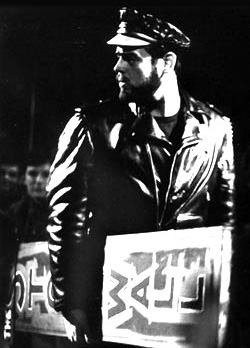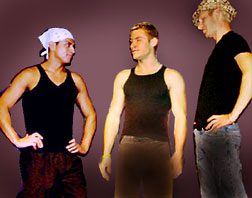|
Welcome to the Archive Version of the online On the Purple Circuit, which ran from 2000-2021. Bill Kaiser founded the Circuit as a newsletter in 1991, and, in 2000, Demian joined as co-editor. Demian programmed the site, expanded the scope of the Circuit, as well as retouched all the images. Demian needed to stop working on the Purple Circuit in order to realize his other projects, such as publishing the book “Operating Manual for Same-Sex Couples: Navigating the rules, rites & rights,” now available on Amazon, and to publishing his “Photo Stories by Demian” books based on his more than 6 decades as a photographer and writer. QueerWise and Michael Kearns have committed to offering a continuation of the Purple Circuit. The new Web address is purplecircuit.org. Bill Kaiser continues as editor and can be reached at purplecir@aol.com Bill and Demian express their appreciation for the hundreds of writers, directors, actors, and publicists who sent their articles and play data. They have toiled mightily to bring our gay, lesbian, trans, and feminist culture into public view, and appreciation. |
| Bill Kaiser, founder (1991), publisher, editor - purplecir@aol.com - 818-953-5096 Demian, associate editor (2000), Web builder, image retouch (since 2003) Contents © 2022, Purple Circuit, 921 N. Naomi St., Burbank, CA 91505 |
|
Street Theater by Doric Wilson June 14, 2000, revised June 1, 2007 |
In the summer of 1980 — as I was passing the site of the Stonewall Inn on Christopher Street — I heard a street queen call out to a girlfriend, “Hi ya, Ceil!, how ya doin’, hun,” and like Proust with a mouthful of Madeleine, I was back in 1969, and not a thing had changed. The rhetoric of liberation to the contrary, and to das fury of Andrew Sullivan and the cadres of straight gays, the stereotypes seem to have survived and flourished. We had not mutated into ranks and files of good little Log Cabin Republicans trooping by in a rainbow display of polo shirts.
I began Street Theater that night in 1969. I wrote most of it on the back of disco promos while employed as the doorman of a nameless (and thankfully for the writing process) unpopular upper west-side bar. The incidents in Street Theater are all autobiographical, including the cops arresting each other, and Seymour offering his nightstick to Jack.
I gave Allan Estes at San Francisco’s Theater Rhinoceros the premier of Street Theater in gratitude for his support of my earlier plays. My main memory of the opening was my 70- year-old mother being physically assaulted in front of the theatre by a disputation of radical lesbians, angry that my play dared to suggest drag queens participated in Stonewall. (No doubt they were the very same women who later hauled the dying Robert Chesley before a Star Chamber to explain why his plays did not gander-step to the beat of political correctness.)
Three New York City productions followed, the first a disastrous showcase at the old TOSOS site directed by a recently reformed dipsomaniac who spent the rehearsal negotiating the twelve steps. An Off-Broadway engagement followed at the Actor’s Playhouse (David Drake’s debut), but Minetta Creek overflowed its underground conduit, flooding the theater and causing Street Theater to sink. As the waters rushed in, Michael Lynch was seen (as rumor has it) running up the aisle screaming, “drag queens first, then women and children!”
Many other dryer productions followed, but it wasn’t until after I directed the play in Seattle and Los Angeles in the late 80s that I was able to put the climax in its proper sequence. In April of 2002, the revised script of Street Theater was given it’s definitive production directed by Mark Finley, and produced by Barry Childs, for TOSOS II to critical acclaim and award nominations at the Eagle, NYC. (An archival DVD of this production is available for free from tosos2@nyc.rr.com)
Since its opening, Street Theater has had multiple productions all over the country, most recently in Omaha, Palm Springs, Memphis, Miami, Fort Lauderdale and New Orleans, where the run closed the night before Katrina arrived. (Because of the precarious condition of my heart, I have very little to say about a pirated and castrated version presented in London in the early 90s under the title “The Night They Buried Judy Garland.”) For the most reliable account of the Stonewall Riots, read David Carter’s “Stonewall,” (St. Martin’s Press). An earlier version of “Street Theater” was published by JH Press (now under the imprimatur T’n’T Classics, Inc.), and is included in the anthology “Out Front” (edited by Don Shewey, Grove Press.) The only version of “Street Theater” authorized for production is published by United Stages. |



